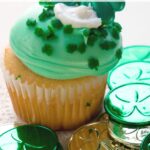Achieving a vibrant, deep red icing is a delightful challenge for bakers, and this guide, brought to you by FOODS.EDU.VN, unveils the secrets to mastering this technique. Learn how to create the perfect shade of red using food coloring, along with tips and tricks to ensure your icing is not only visually stunning but also tastes amazing. Unlock expert knowledge and explore a world of culinary possibilities with FOODS.EDU.VN, your gateway to in-depth culinary expertise, including baking tips, decorating advice, and frosting techniques.
1. Understanding the Basics of Red Icing Color
Creating a deep red icing isn’t as simple as just adding red food coloring. Several factors influence the final color, including the type of icing, the base color, and the kind of food coloring you use. Let’s explore these elements to set the stage for success.
1.1. Types of Icing and Their Impact on Color
The type of icing you choose significantly affects how the red color develops. American buttercream, known for its naturally white base, is often preferred as it provides a neutral canvas for achieving vibrant colors. Cream cheese frosting, with its slight tang, can also be used, offering a unique flavor profile that complements the richness of the red color.
| Icing Type | Base Color | Flavor Profile | Suitability for Red Icing |
|---|---|---|---|
| American Buttercream | White | Sweet, buttery | Excellent |
| Cream Cheese Frosting | Off-white | Tangy, rich | Good |
| Swiss Meringue | White | Light, airy | Excellent |
| French Buttercream | Yellowish | Rich, buttery | Requires more coloring |
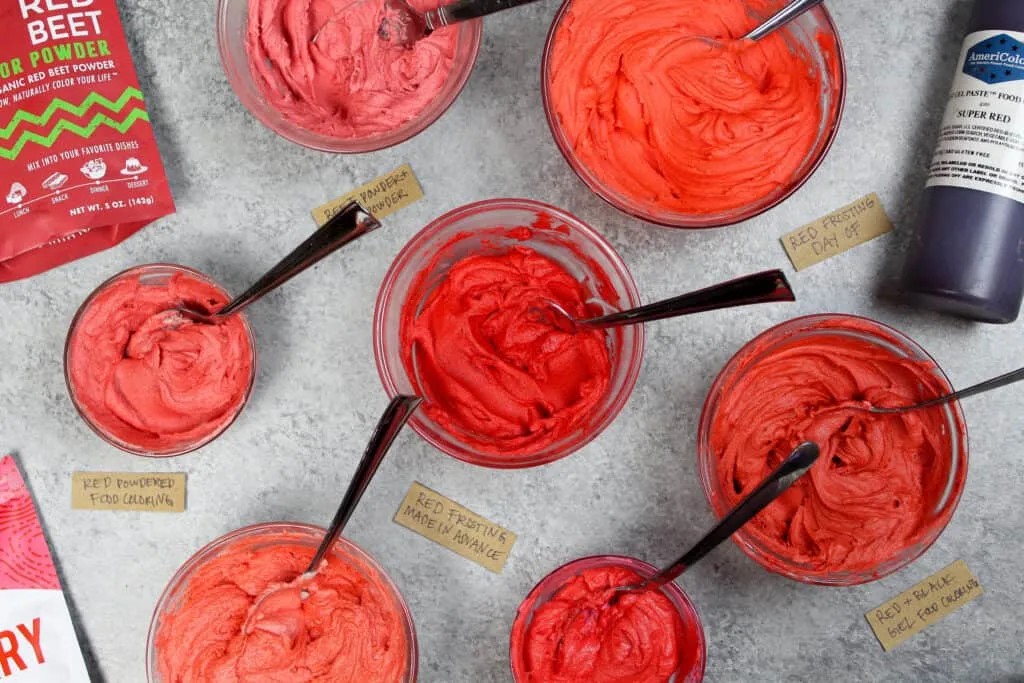
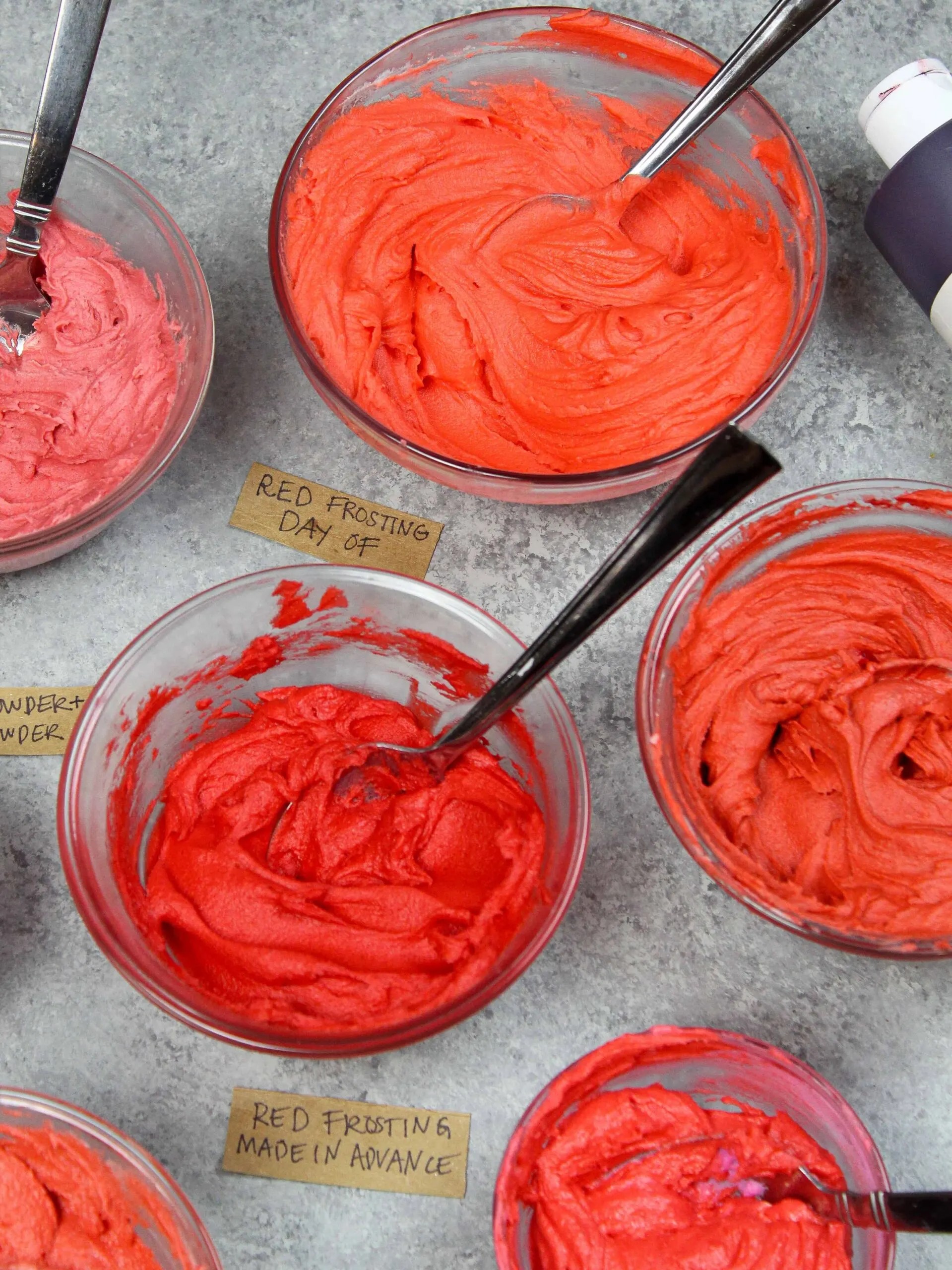
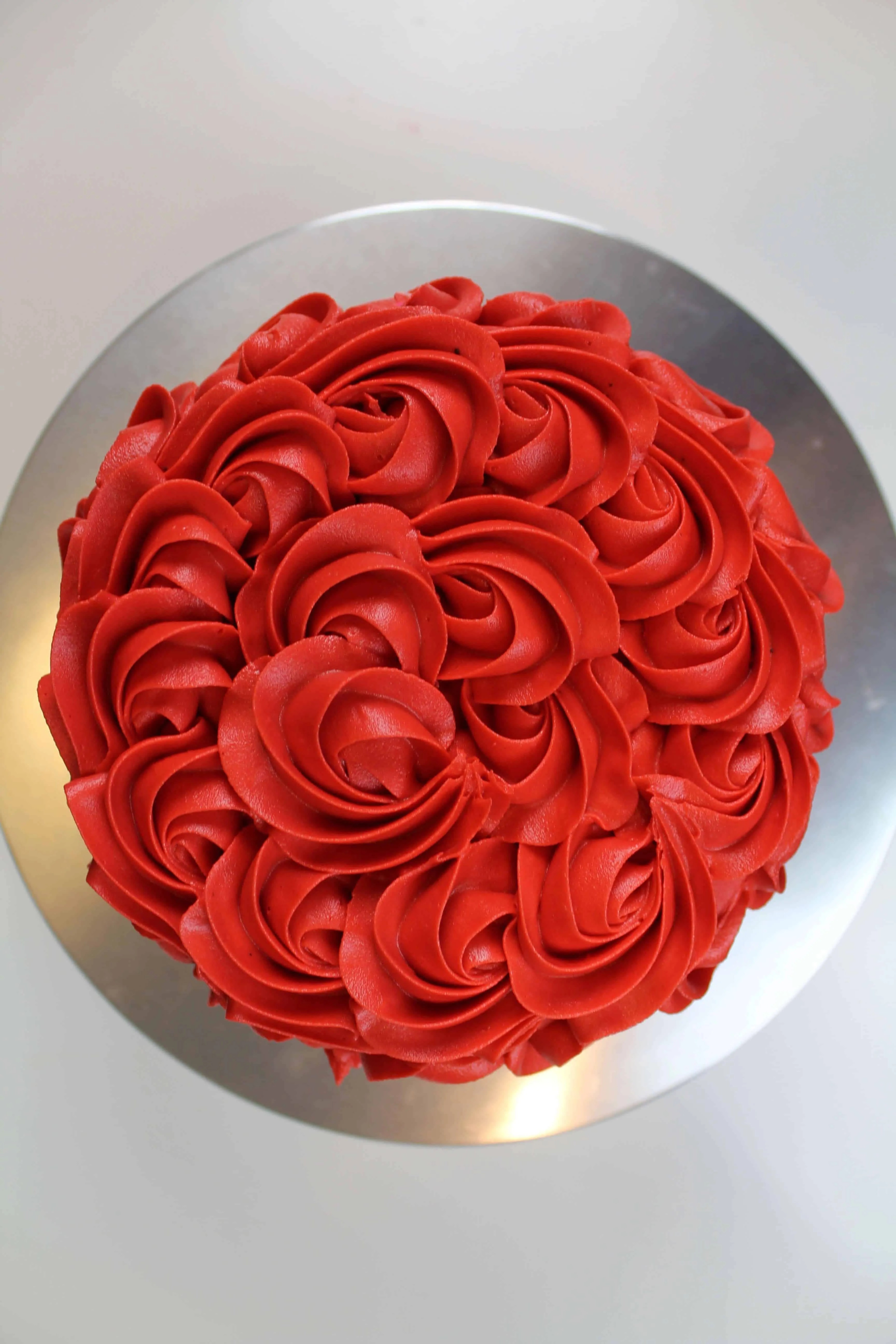
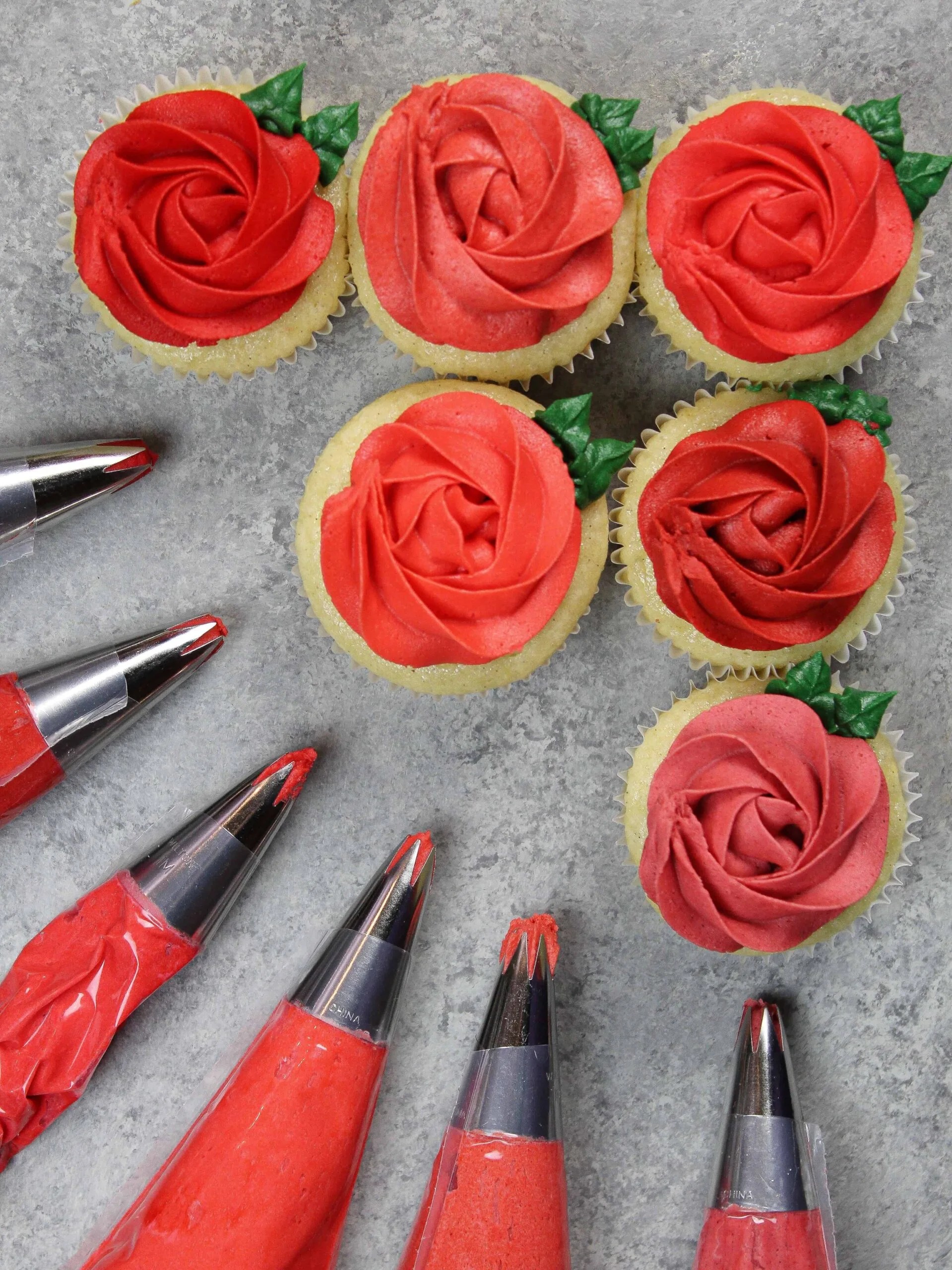
1.2. The Importance of a White Base
A pure white base is essential for achieving a true red color. If your icing has a yellowish tint, it can distort the red, resulting in a less vibrant or even orange-toned hue. Using a high-quality butter that’s pale in color can help create a whiter base. Alternatively, you can add a tiny amount of violet food coloring to neutralize any yellow tones.
1.3. Selecting the Right Food Coloring
The type of food coloring you choose is critical. Gel food coloring is highly recommended due to its concentrated formula. Unlike liquid food coloring, gels won’t alter the consistency of your icing, and you’ll need less to achieve the desired color. Brands like Americolor and Chefmaster are known for their vibrant and true-to-color gel options.
2. Choosing the Right Type of Food Coloring
Not all food colorings are created equal, especially when it comes to achieving that perfect, deep red hue. Understanding the different types available and their unique properties is key to success.
2.1. Gel Food Coloring: The Baker’s Best Friend
Gel food coloring is a staple in any baker’s toolkit, especially for achieving intense colors like deep red. Its concentrated formula means you can add a small amount and still get a vibrant result, without affecting the consistency of your icing.
- Pros: Highly concentrated, doesn’t alter icing consistency, available in a wide range of colors.
- Cons: Can be more expensive than liquid food coloring, some brands may have a slightly bitter aftertaste.
2.2. Liquid Food Coloring: Proceed with Caution
Liquid food coloring, commonly found in supermarkets, is less concentrated than gel and can significantly alter the consistency of your icing, making it too thin. It’s generally not recommended for achieving deep, vibrant colors.
- Pros: Widely available, inexpensive.
- Cons: Less concentrated, can change icing consistency, requires a large amount to achieve desired color.
2.3. Powdered Food Coloring: A Natural Alternative
Powdered food coloring is a great option if you’re looking for a natural alternative to artificial dyes. It’s made from concentrated pigments and can deliver vibrant colors without the additives found in some gel and liquid colorings.
- Pros: Natural option, doesn’t alter icing consistency, long shelf life.
- Cons: Can be more difficult to find, may require more product to achieve desired color, some may affect flavor slightly.
2.4. Natural Food Coloring: A Health-Conscious Choice
For those prioritizing natural ingredients, natural food colorings derived from fruits, vegetables, and plants are an excellent choice. Beetroot powder, for example, can impart a lovely red hue to your icing, though it may not be as intense as artificial dyes.
- Pros: All-natural, derived from fruits and vegetables.
- Cons: Color may be less vibrant, can affect flavor, may require larger quantities.
3. The Secret Ingredient: Time
Time is your ally when it comes to achieving a deep red icing. Allowing the color to develop over time can significantly enhance its vibrancy.
3.1. Making Icing in Advance: Color Development
One of the most effective tricks is to make your icing a day or two in advance. The color will deepen as the icing sits, allowing the food coloring to fully saturate the mixture. Store the icing in an airtight container in the refrigerator, and let it come to room temperature before using.
3.2. The Science Behind Color Deepening
The color deepening process is due to the interaction between the food coloring molecules and the icing’s ingredients. As the mixture sits, the color molecules fully disperse and bind with the fats and sugars, resulting in a richer, more intense hue.
3.3. Storage Tips for Optimal Color
Proper storage is crucial for maintaining the color and consistency of your icing. Always use an airtight container to prevent the icing from drying out or absorbing odors from the refrigerator. When ready to use, allow the icing to come to room temperature and give it a good stir to restore its smooth texture.
4. Techniques for Enhancing Red Color
Beyond choosing the right food coloring and allowing time for color development, there are several techniques you can use to further enhance the red hue of your icing.
4.1. The Microwave Method: A Quick Boost
If you’re short on time or need an extra boost of color, the microwave method can work wonders. Scoop a small amount of icing into a microwave-safe bowl, add additional food coloring, and microwave for a few seconds until the icing is slightly melted. Mix well and add it back to the rest of the icing. This helps to intensify the color and create a more uniform hue.
4.2. Starting with a Pink Base: Layering Colors
An interesting trick is to start with a pink base before adding red food coloring. This can help to create a deeper, more vibrant red color, as the pink undertones enhance the overall hue.
4.3. Adding a Touch of Black: Depth and Richness
Adding a tiny drop of black gel food coloring can deepen the red and create a richer, more intense hue. Be careful not to add too much, as it can turn the icing a muddy color. Start with a very small amount and mix well before adding more.
5. Addressing the Bitter Taste Problem
One common issue with using a lot of red food coloring is the potential for a bitter aftertaste. Here’s how to combat it:
5.1. Choosing “No Taste” Red Food Coloring
Some brands offer “no taste” red gel food coloring, which is specially formulated to minimize any bitter aftertaste. While it may not completely eliminate the taste, it can make a significant difference.
5.2. Flavoring the Icing: Masking the Bitterness
Adding a complementary flavor to your icing can help mask any potential bitterness from the food coloring. Vanilla extract, almond extract, or even a hint of citrus can work wonders.
5.3. Using Cream Cheese Frosting: A Tangy Solution
Cream cheese frosting naturally has a tangy flavor that can counteract any bitterness from the red food coloring. This is a great option if you enjoy the taste of cream cheese in your icing. The team at FOODS.EDU.VN find this to be the best method.
6. Step-by-Step Guide: Making Deep Red Icing
Now, let’s put it all together with a detailed, step-by-step guide to making deep red icing.
6.1. Gathering Your Ingredients
Here’s what you’ll need:
- 2 cups (4 sticks) unsalted butter, softened
- 4 cups powdered sugar
- 1/2 teaspoon salt
- 2 tablespoons milk or cream
- 1 teaspoon vanilla extract
- Red gel food coloring (Americolor Super Red recommended)
6.2. Preparing the Buttercream Base
- In a large mixing bowl, beat the softened butter until smooth and creamy.
- Gradually add the powdered sugar, one cup at a time, mixing on low speed until fully incorporated.
- Add the salt, milk or cream, and vanilla extract. Beat on medium speed until the icing is light and fluffy.
6.3. Adding the Red Food Coloring
- Add a generous amount of red gel food coloring to the buttercream. Start with a teaspoon and mix well.
- Continue adding food coloring, a little at a time, until you reach the desired shade of red. Remember that the color will deepen over time.
6.4. Achieving the Perfect Consistency
- If the icing is too thick, add a little more milk or cream until it reaches a smooth, spreadable consistency.
- If the icing is too thin, add a little more powdered sugar until it thickens up.
6.5. Letting the Color Develop
- Transfer the icing to an airtight container and store it in the refrigerator for at least a few hours, or preferably overnight.
- Before using, let the icing come to room temperature and give it a good stir to restore its smooth texture.
7. Troubleshooting Common Issues
Even with the best techniques, you might encounter some challenges along the way. Here’s how to troubleshoot common issues:
7.1. Icing is Too Thin
If your icing is too thin, it can be difficult to work with and may not hold its shape well. Here’s how to fix it:
- Add More Powdered Sugar: Gradually add powdered sugar, one tablespoon at a time, until the icing reaches the desired consistency.
- Chill the Icing: Refrigerate the icing for 15-20 minutes to help it firm up.
- Use Cornstarch: In a pinch, you can add a small amount of cornstarch to help thicken the icing.
7.2. Icing is Too Thick
If your icing is too thick, it can be difficult to spread and may crack easily. Here’s how to fix it:
- Add Liquid: Gradually add milk or cream, one teaspoon at a time, until the icing reaches the desired consistency.
- Warm the Icing: Let the icing sit at room temperature for a few minutes to soften.
- Beat the Icing: Beat the icing on low speed with an electric mixer to help loosen it up.
7.3. Bitter Aftertaste
As previously discussed, a bitter aftertaste is a common issue with red food coloring. Here’s a recap of how to address it:
- Use “No Taste” Food Coloring: Opt for a “no taste” red gel food coloring.
- Flavor the Icing: Add extracts like vanilla or almond to mask the bitterness.
- Use Cream Cheese Frosting: The tangy flavor of cream cheese can help counteract the bitterness.
7.4. Uneven Color
If your icing has an uneven color, it can be visually unappealing. Here’s how to fix it:
- Mix Thoroughly: Ensure that the food coloring is fully incorporated by mixing the icing thoroughly.
- Microwave Method: Use the microwave method to intensify the color and create a more uniform hue.
- Let it Rest: Allow the icing to rest for a few hours, as the color will often even out over time.
8. Creative Uses for Deep Red Icing
Now that you’ve mastered the art of making deep red icing, let’s explore some creative ways to use it.
8.1. Valentine’s Day Treats: Spreading the Love
Deep red icing is perfect for Valentine’s Day treats, from heart-shaped cookies to decadent cupcakes. Use it to create romantic designs and spread the love.
8.2. Christmas Desserts: A Festive Touch
Add a festive touch to your Christmas desserts with deep red icing. Use it to decorate gingerbread cookies, cupcakes, or even a stunning Yule log cake.
8.3. Themed Birthday Cakes: Adding a Pop of Color
Whether you’re making a superhero cake or a ladybug-themed creation, deep red icing can add a pop of color and excitement to any birthday celebration.
8.4. Floral Designs: Creating Stunning Visuals
Create stunning floral designs on your cakes and cupcakes with deep red icing. Use it to pipe roses, petals, and other intricate details.
9. Exploring Different Shades of Red
While deep red is a classic choice, there are many other shades of red to explore. Experiment with different food colorings and techniques to create a range of hues.
9.1. Crimson: A Rich and Intense Hue
Achieve a crimson shade by using a combination of red and a touch of burgundy food coloring. This creates a rich and intense hue that’s perfect for elegant designs.
9.2. Scarlet: A Bright and Bold Choice
Create a scarlet shade by using a bright red food coloring with a hint of orange. This results in a bold and vibrant color that’s sure to make a statement.
9.3. Burgundy: A Deep and Sophisticated Shade
Achieve a burgundy shade by using a combination of red and a touch of purple food coloring. This creates a deep and sophisticated color that’s perfect for fall and winter desserts.
9.4. Raspberry: A Sweet and Fruity Hue
Create a raspberry shade by using a combination of red and a touch of pink food coloring. This results in a sweet and fruity color that’s perfect for summer treats.
10. Advanced Techniques for Expert Bakers
For expert bakers looking to take their deep red icing to the next level, here are some advanced techniques to try:
10.1. Airbrushing: Achieving Smooth and Even Color
Airbrushing is a great way to achieve smooth and even color on your cakes and cupcakes. Use an airbrush to apply a thin layer of deep red food coloring, creating a flawless finish.
10.2. Ombre Effects: Blending Shades Seamlessly
Create stunning ombre effects by blending different shades of red icing. Start with a light shade at the top and gradually transition to a darker shade at the bottom for a visually appealing gradient.
10.3. Stenciling: Creating Intricate Designs
Use stencils to create intricate designs on your cakes and cupcakes with deep red icing. This is a great way to add a professional touch to your creations.
11. Nutritional Information and Considerations
When using food coloring, it’s important to be mindful of the nutritional information and potential health considerations.
11.1. Artificial vs. Natural Food Coloring
Artificial food colorings are synthetic dyes that are widely used in the food industry. While they are generally considered safe, some people may be sensitive to them. Natural food colorings are derived from fruits, vegetables, and plants, and are a healthier alternative.
11.2. Potential Allergies and Sensitivities
Some people may be allergic or sensitive to certain food colorings. If you have any concerns, it’s best to use natural food colorings or consult with a healthcare professional.
11.3. Sugar Content and Dietary Restrictions
Be mindful of the sugar content in your icing, especially if you have any dietary restrictions. You can reduce the sugar content by using sugar substitutes or alternative sweeteners.
12. Storing and Preserving Deep Red Icing
Proper storage is essential for maintaining the quality and freshness of your deep red icing.
12.1. Refrigeration Guidelines
Store your icing in an airtight container in the refrigerator for up to a week. Let it come to room temperature before using and give it a good stir to restore its smooth texture.
12.2. Freezing Instructions
For longer storage, you can freeze your icing in an airtight container for up to three months. Thaw it in the refrigerator overnight and give it a good stir before using.
12.3. Preventing Color Fading
To prevent the color from fading, store your icing in a dark, cool place away from direct sunlight. You can also add a small amount of citric acid to help preserve the color.
13. Expert Tips for Success
Here are some final expert tips to help you achieve deep red icing perfection:
13.1. Use High-Quality Ingredients
Using high-quality ingredients, such as real butter and pure vanilla extract, will result in a better-tasting and better-looking icing.
13.2. Don’t Overmix
Overmixing can cause the icing to become tough and dense. Mix until the ingredients are just combined.
13.3. Practice Makes Perfect
Don’t be discouraged if your first attempt isn’t perfect. Practice makes perfect, so keep experimenting and refining your technique.
14. The Future of Food Coloring in Baking
The world of food coloring is constantly evolving, with new innovations and trends emerging all the time.
14.1. Innovations in Natural Food Coloring
Researchers are constantly developing new and improved natural food colorings that offer vibrant colors without the additives found in artificial dyes.
14.2. Sustainable and Eco-Friendly Options
Sustainable and eco-friendly food coloring options are becoming increasingly popular, as consumers become more conscious of the environmental impact of their food choices.
14.3. Personalized and Customizable Colors
Personalized and customizable food colors are on the rise, allowing bakers to create unique and one-of-a-kind creations.
15. Resources and Further Learning
To continue your journey of deep red icing mastery, here are some valuable resources and further learning opportunities:
15.1. Online Baking Communities and Forums
Join online baking communities and forums to connect with other bakers, share tips and tricks, and get inspiration for your creations.
15.2. Baking Classes and Workshops
Attend baking classes and workshops to learn from expert instructors and refine your skills.
15.3. Recommended Books and Websites
Explore recommended books and websites for in-depth information on baking techniques, food coloring, and more. For instance, FOODS.EDU.VN offers extensive resources on various baking and pastry topics.
16. Frequently Asked Questions (FAQs)
1. What type of food coloring is best for achieving a deep red icing?
Gel food coloring is highly recommended due to its concentrated formula and ability to deliver vibrant colors without altering the consistency of your icing.
2. How can I prevent a bitter aftertaste when using red food coloring?
Use “no taste” red gel food coloring, flavor the icing with extracts like vanilla or almond, or use cream cheese frosting, which naturally has a tangy flavor that can counteract the bitterness.
3. Can I make deep red icing in advance?
Yes, making your icing a day or two in advance can significantly enhance the color vibrancy. Store the icing in an airtight container in the refrigerator and let it come to room temperature before using.
4. What can I do if my icing is too thin?
Gradually add powdered sugar, one tablespoon at a time, until the icing reaches the desired consistency. You can also chill the icing for 15-20 minutes to help it firm up.
5. How do I store deep red icing?
Store your icing in an airtight container in the refrigerator for up to a week or in the freezer for up to three months.
6. Can I use natural food coloring to achieve deep red icing?
Yes, natural food colorings like beetroot powder can impart a lovely red hue to your icing, though it may not be as intense as artificial dyes.
7. What is the microwave method for enhancing red color?
Scoop a small amount of icing into a microwave-safe bowl, add additional food coloring, and microwave for a few seconds until the icing is slightly melted. Mix well and add it back to the rest of the icing.
8. How can I create an ombre effect with deep red icing?
Blend different shades of red icing, starting with a light shade at the top and gradually transitioning to a darker shade at the bottom for a visually appealing gradient.
9. What are some creative uses for deep red icing?
Use it for Valentine’s Day treats, Christmas desserts, themed birthday cakes, or floral designs on your cakes and cupcakes.
10. Are there any potential allergies or sensitivities associated with food coloring?
Some people may be allergic or sensitive to certain food colorings. If you have any concerns, it’s best to use natural food colorings or consult with a healthcare professional.
We hope this comprehensive guide has empowered you with the knowledge and skills to create stunning deep red icing. Remember, the journey to culinary mastery is a continuous process of learning and experimentation.
Ready to elevate your baking skills further? Visit FOODS.EDU.VN today for a treasure trove of in-depth articles, expert tips, and delicious recipes that will inspire your culinary creativity. From mastering fundamental techniques to exploring the latest trends, FOODS.EDU.VN is your ultimate resource for all things culinary. Join our community of passionate food enthusiasts and unlock a world of gastronomic possibilities. Your next baking adventure awaits at FOODS.EDU.VN!
FOODS.EDU.VN
Address: 1946 Campus Dr, Hyde Park, NY 12538, United States
Whatsapp: +1 845-452-9600
Website: foods.edu.vn
